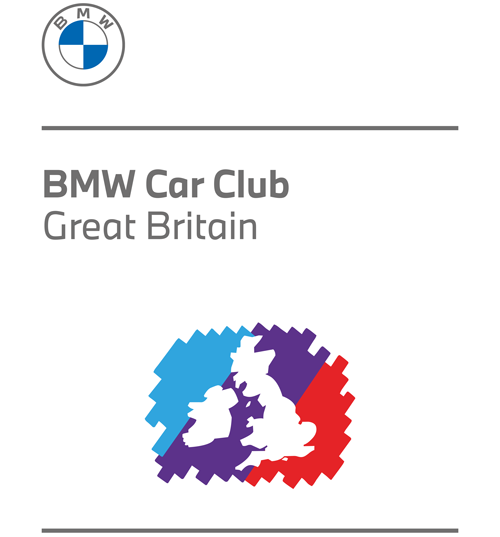Straight Six magazine December 2015 pages 29-31
Words by John Castle & Richard Baxter
Images BMW Press, John & Richard
There is a myth that the 3.0 CSL was designed in 1972 so that 1,000 cars could be produced to meet the FIA homologation regulations for the 1972 Group 2 European Touring Car Championship (ETCC). In fact the production homologation conditions for 1972 were not achieved in time and the application to the FIA (Number 1648) for the CSL was not made until 28 November 1972. Even then BMW were ‘economic’ with the facts and claimed that production of the lightweight shell had started on 1 December 1971 and that by the 28 November 1972 “1000 had been produced” even though production then continued until July 1973 by which time 1,039 had been produced, the last 109 cars being the first series of ‘Batmobiles’ with the aerodynamic kit supplied in the boot to be fitted by the dealer. The only possible way that BMW might have justified that 1,000 cars had been produced in 1972 was to count unfinished shells at the Karmann, Osnabruck, factory which were then completed in 1973.
In reality the CSL was ‘evolved’. When the E9 was introduced in 1969 BMW were heavily involved in Formula 2 competitions so that the 2800CS was outsourced to Alpina and Schnitzer with some financial assistance to race in the ETCC. Up against the Ford RS 2600 and race prepared Alfa Romeos, the 2800 was too heavy (300kg more than a RS2600) and it was better known for its long distance reliability than for outright speed in the sprint events. The introduction and homologation of the 3.0 CSi in July 1971 helped a little with the new engine in competition trim producing over 300hp which matched the Westlake tuned 3.0 V-six Ford engines, but the weight of the E9 shell was still too much of a handicap for the CS to win consistently.
Because this ‘weight’ problem was well known, and prompted by Alpina, the factory used some development money with Karmann during 1970 to fabricate some lightweight shells. Outer body panels in 22 gauge steel instead of the heavier 18 gauge were relatively straightforward to press, and in addition work was carried out to fabricate alloy bonnets, boot lids and doors. This is not as easy as it sounds because aluminium work hardens easily when bent, and it thins when bent around tight corners and can crack, so development took most of the year. In May 1971 Karmann, who now had the confidence to produce the new shells, were asked to produce two ‘lightweight’ shells to send to Ralph Broad at Broadspeed in Southam, Warwickshire, to modify to the absolute limit of the homologation regulations at the time. Later, in August, BMW were sufficiently confident to market the ‘Lightweight’, using Alpina at Buchloe to assemble the cars using the 3.0CS 180bhp carburettor engine. The lightweights were prohibitively expensive and built to order so that only 169 were eventually sold.

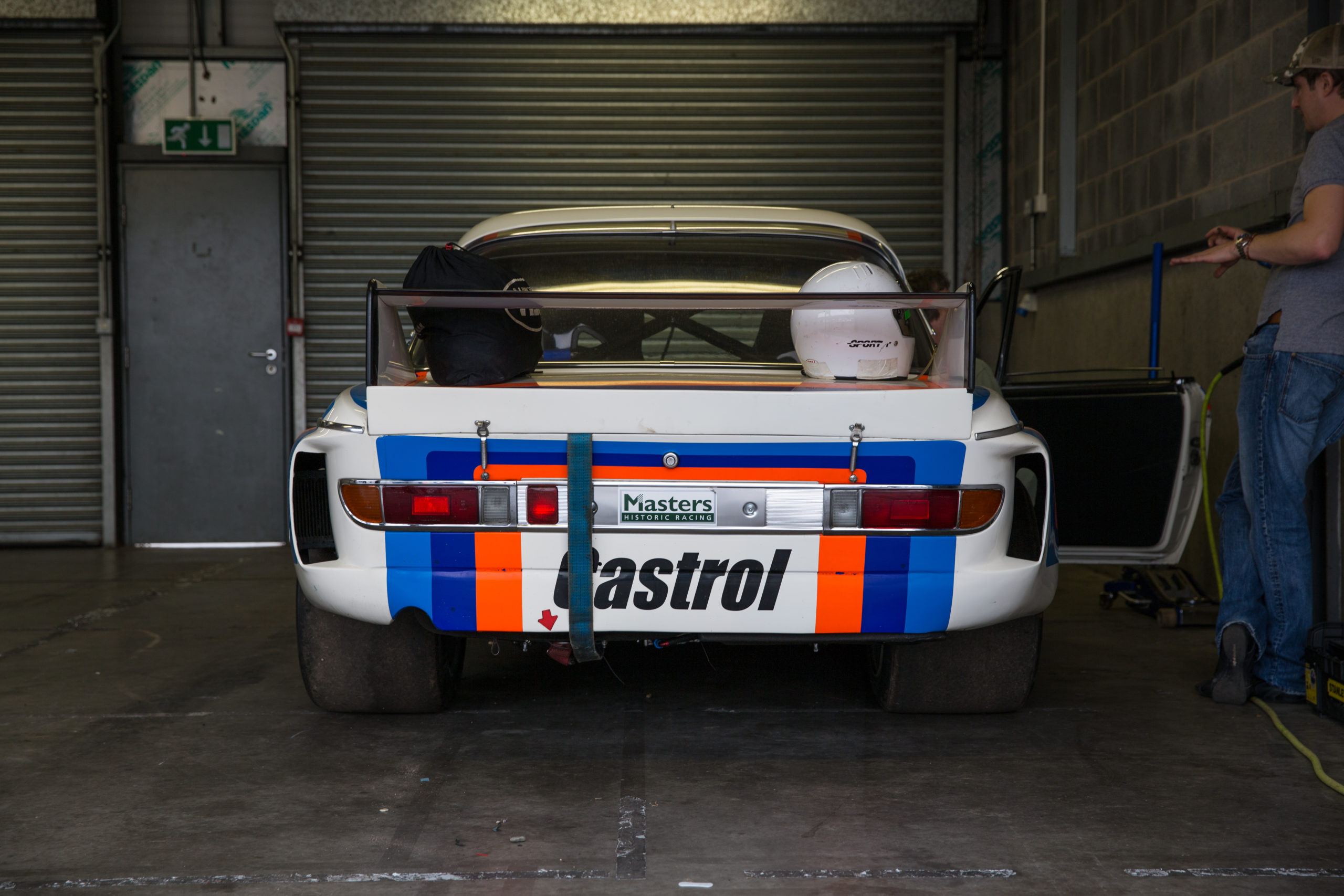
During 1971, Ralph Broad, who was a suspension ‘guru’, very quickly developed a flat faced front spoiler to destroy any front end lift and lowered the ride height by developing, with the German company Bilstein, a set of progressive rate springs and shock absorbers. He also fitted the car with wider GRP wheel arches and wider wheels. At the same time Paul Rosche, who was Head of Race Engine Development, was able to provide a 3 litre race engine using Kugelfischer mechanical fuel injection, larger valves and most important, a lighter crankshaft developed by Dr. Fritz Indra of Alpina, which allowed the engine to develop 332bhp and rev to 8000rpm, where previously the crankshaft had a habit of breaking over 7000rpm. The first car was raced in April 1972 at the Saltzburgring but was constantly involved in scrutinising issues and thereafter the two cars were just used for testing. But two vital items of the definitive CSL had ‘evolved’ – the front spoiler and the progressive rate springs and shock absorbers which later appeared on the production cars.
Things were also changing at management level and Bob Lutz, an American, had joined the Board as Sales Director from General Motors (Opel) in January 1972. With his experience from the States he knew that competition success sold cars, and with the two cars completing preparation in the UK he poached Jochen Neerpasch and his technical manager Martin Braungart from the Ford Cologne team to join BMW in May 1972. Their first task was to set up BMW Motorsport GmbH on 24 May 1972 and to establish a team to compete in the ETCC in 1973.
Their first act was to get Board approval to start the proper production of the CS ‘Leichtmetal’ cars to have at least 1,000 built by the autumn homologation deadline. In addition to the lightweight shell, the specification included Perspex side windows, thin toughened windscreens, the front spoiler but no front bumper and the Bilstein suspension set up mentioned above, a limited slip differential, GRP rear bumper, manual steering, no interior sound deadening, very little under-seal, and lightweight proprietary Scheel seats.
For the team, Neerspatch had 21 lightweight shells delivered to their base in Preusenstrasse in Milbertshofen, outside Munich, to start preparing the race cars. Many years later Neerspatch said in an interview that he, Braungart and a single draftsman had to design titanium/alloy ‘coil over’ front suspension struts, new rear trailing arms to accommodate wider wheels, new centre lock wheel hubs, a large 120 litre fast fill fuel tank, uprated brake discs and callipers, an alloy differential with interchangeable ratios and a belt driven pump for al cooling system, two different 5 speed gearboxes and two- and three-plate clutches. To take advantage of the better range of Dunlop racing tyres, the wheel size was changed to 15″, 11.5″ wide at the front, 13.2″ at the rear, and the distinctive and still impressive Motorsport Team colour scheme was prepared by Wolfgang Seehaus in the factory drawing office.
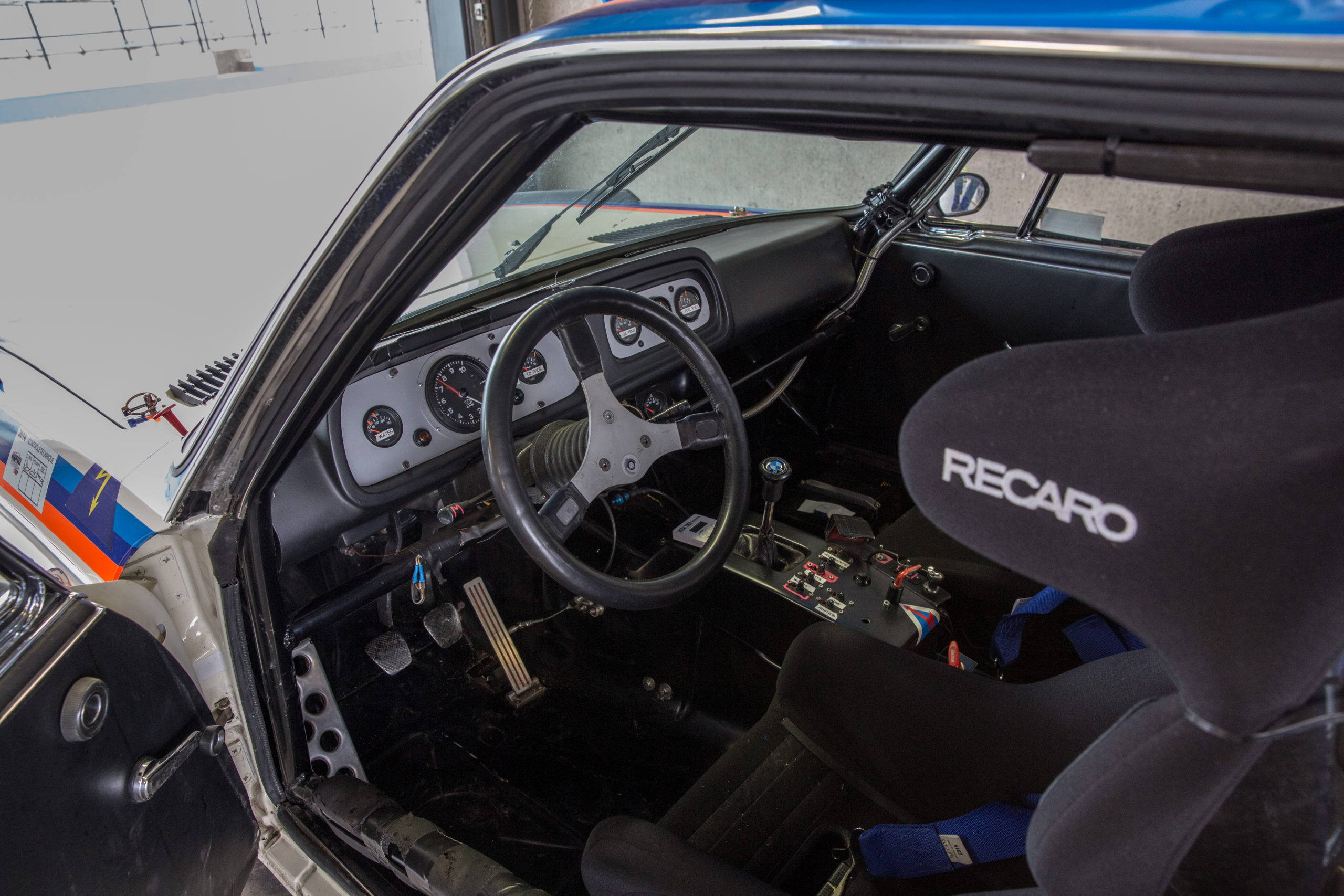
The 3 litre engine developed for the Broadspeed cars was further improved. The cylinders were bored out to 94mm, the 46mm inlet valve size was increased to 50mm and the exhaust from 38mm to 42mm, dry sump lubrication was introduced with a three stage oil pump and the rocker cover was magnesium.
Overall the package was a car weighing 1062kg, producing 365bhp compared to the new Ford Capri RS3000 at 900kg and 320bhp.
Because the team had no idea how many cars they would build, the first car was given the VIN 227600 with all further cars to be numbered downwards. 227600 was completed in mid 1972 and was used for testing at the Paul Ricard circuit. 227599 was used for testing and by Harald Menzel and Hans Stuck for the German National Touring Car Championship. It was first in the 1973 Nurburgring 6 hours and later was the first team car fitted with the aerodynamic improvements of splitters, roof hoop, fins, boot spoiler and wing which so demoralised Ford. It all it competed in 11 races but only won once.
275998 was regularly used in 1973 by Toine Hezemans and Dieter Quester to win at Le Mans, Spa 24 Hours and Paul Ricard, and to come second at the Nurburgring 6 Hours. It achieved three wins and one second place out of eight races and is probably the best known team car from 1973.
2275997 was normally used by Hans Stuck and Chris Amon and competed in 4 ETCC rounds. Four other shells, 2275996 to 993, were completed, two of which were sold to customers, one was a spare and the other was retained for the factory museum.
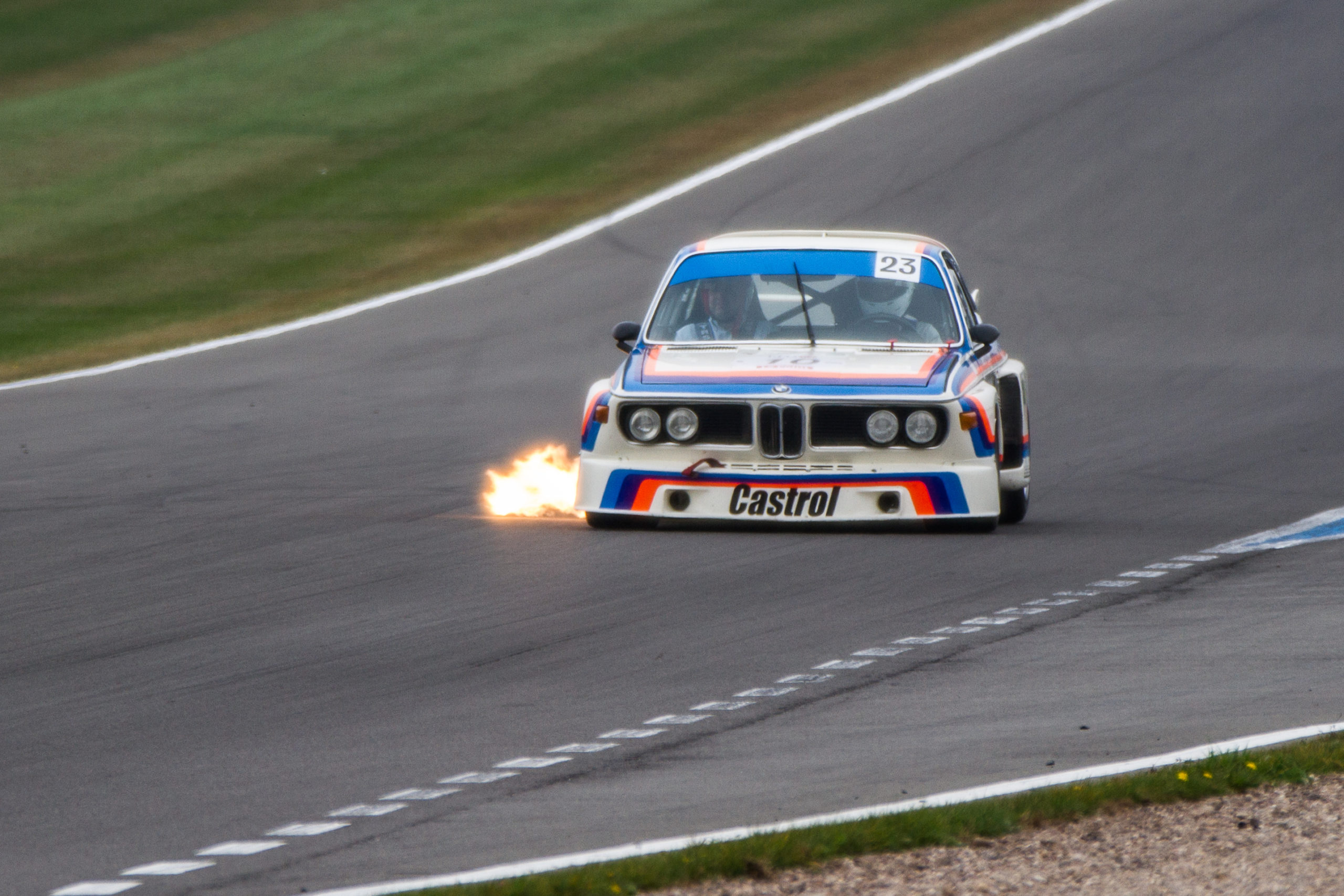
CSL Homage R
In hindsight the E9 CSL from the 1970s was a massively important car to BMW at the time. Racing has always existed deeply in the DNA of the company and with the growing confidence since the company’s increased shareholding by the Quandt family in 1960, there was great determination to develop and expand the company.
In just 12 years, BMW formed BMW Motorsport GmbH to combine its many racing activities under a single banner; at a stroke M Power was on the map. The first car to benefit from this new focus was the E9 CSL coupe. The coupe developed into a very successful racing car in both Europe and the USA, winning championships even after production had ceased.
This was achieved by the successful incorporation of lightweight materials and intelligent use of harnessing aerodynamic down force. It is generally accepted that an M car is defined by being fitted with a Motorsport engine; the M49 double overhead camshaft is just such an engine and technically became the first M car in all but name.
To pay homage to the 40 year old race cars, BMW have produced the ‘BMW 3.0 CSL Homage R’ to celebrate and showcase how they have incorporated the latest thinking in a traditional sense. This new car embraces the lightweight materials of carbon fibre and aluminium.
The power plant, an inline 6 cylinder eboost hybrid; but first a little history on the evolution of the original CSL.
Richard Baxter
The BMW Group has come up with something very special this year with the world premiere of the BMW 3.0 CSL Homage R.
With over 40 years now passed since the heady and successful days of the CSL in the 1970s it is fitting that such a striking Homage has been produced, cleverly combing the very latest technology with encompassing the styling cues along with those evocative ‘Motorsport’ stripes.
“Motor racing is all about the ability of cars to mesmerise, about the unbridled joy of driving,” explains Adrian van Hooydonk, Senior Vice President BMW Group Design. “And as such it represents the heartbeat of BMW”.
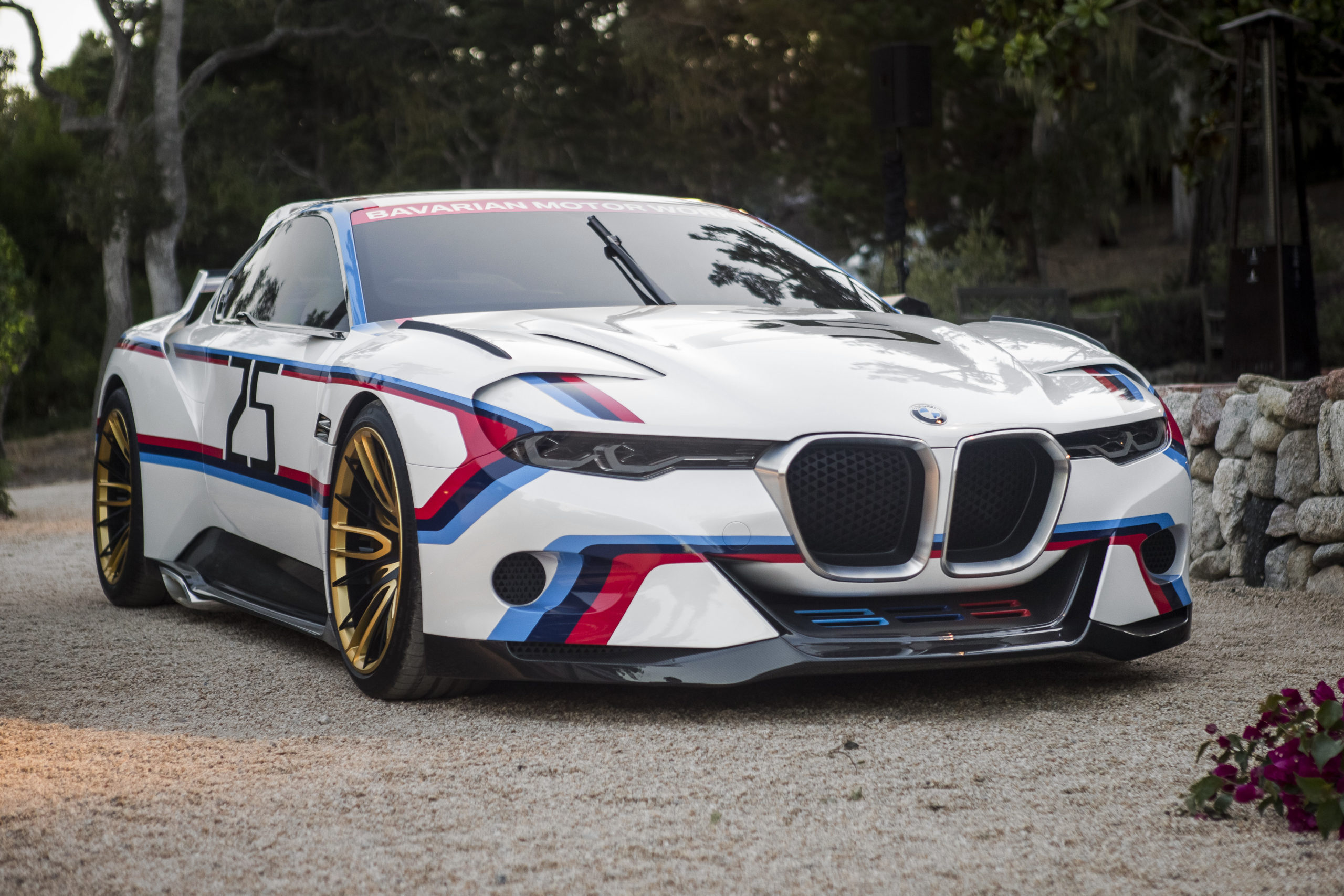
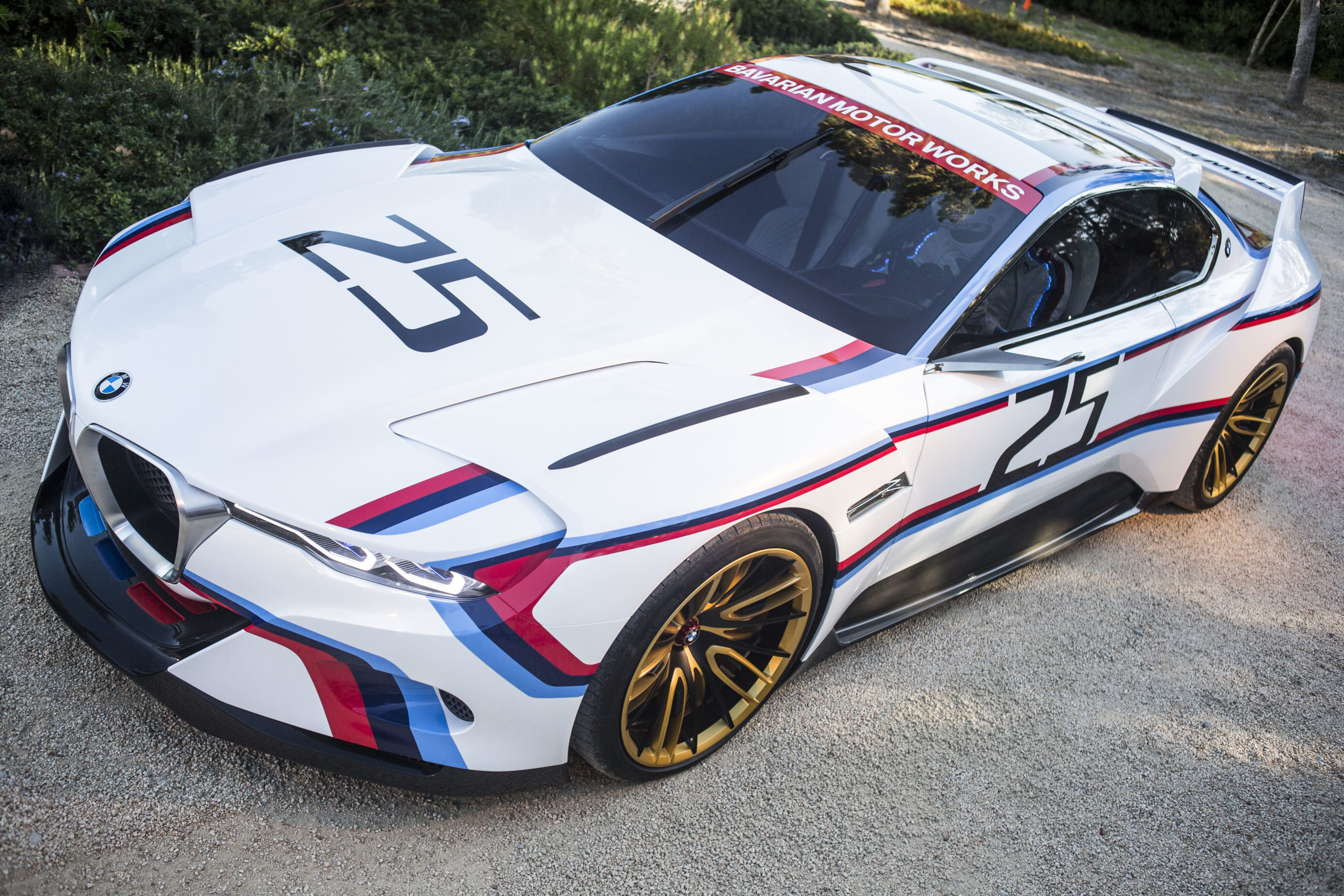
A new level of driver focus – the interior
For the seamless integration of the driver into the car, the designers extrapolated the principle of driver focus beyond the form of the interior. This approach led the designers first to the driver’s helmet, race suit and seat before moving onto the lines and surfaces of the interior.
This way of doing things changes the nature of conventional interior functions. As the layer of interaction closest to the driver, the helmet visor assumes the functions of a display and projects situation-based information such as the car’s speed, gear engaged and engine revs into the driver’s direct field of view.
The idea of the Head-Up Display, which has already proved its effectiveness in series-produced BMW models by flagging up driving-related information without distracting the driver, is therefore expressed in a whole new way: “Eyes on the road, hands on the wheel”, enabling the driver to concentrate fully on the job of driving the car.
The seats ensure the driver’s body has the best possible connection with the car, giving him a physical feel for it with almost his whole body, and thus allowing him to react faster and more effectively.
BMW Motorsport’s signature stripes on the six-point safety harness add an extra splash of colour.
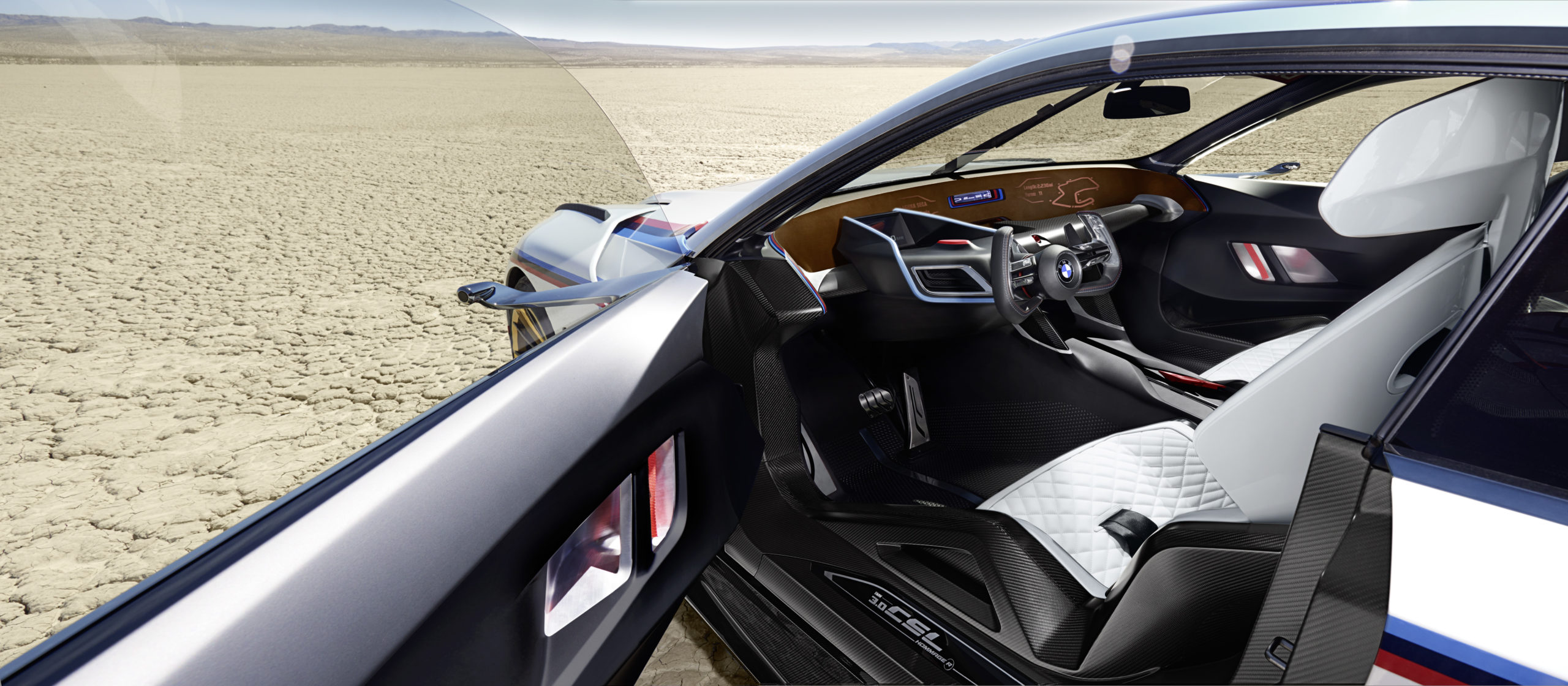
Lightweight construction and technical refinement
A carbon-fibre roll cage is integrated into the structure of the car’s roof and side sections. All the elements in the interior are there out of absolute necessity to integrate with the structure of the machine or the job of driving.
In an interior made almost entirely from carbon fibre, the only wood-like presence is to match the original CSL ‘instrument panel’. A particular highlight here is the additional information illuminated through the wood, for in the Homage R it cleverly displays the track layout and braking points!
By using light in this way, this ultra-sophisticated information display removes the need for conventional dials and slips perfectly into the car’s minimalist interior design philosophy. Only the small central eBoost charging display interrupts the flow of the otherwise unbroken wooden surface.
The commitment to paring the car down to the bare essentials places particular emphasis on the steering column. As a mechanical link between the driver and car, it is home to all the operating elements and controls.
A small display on the steering column provides the driver with secondary information such as lap times, overall race time and the car’s current track position. Other racing elements in the interior include red anodised safety features, such as the outlet nozzles for the fire extinguishing foam, the extinguisher itself, and the two switches on the centre console for the emergency shut-off and fire extinguishing mechanism.

Underneath the longitudinal braces jutting out to the rear are the covers for the eBoost energy accumulators.
Motor racing through and through – the exterior
“Both inside and outside, the CSL Homage R is primarily a reflection of its function,” explains Karim Habib, Head of Design BMW Automobiles. “The exterior and interior design are based around the requirements of motor sport as far as the car and driver are concerned. At the same time, all the details from the classic BMW 3.0 CSL are present in the Homage model. And they are all there to be discovered in their original form”.
The exterior design of the CSL Homage R is a pure expression of motor racing. Distinctive air deflectors, powerful wheel arches and a prominent rear spoiler frame the stretched body. Every detail of the Homage car has its origins in the successful racing machine of the past, but all have since been updated and integrated technically into a modern design.
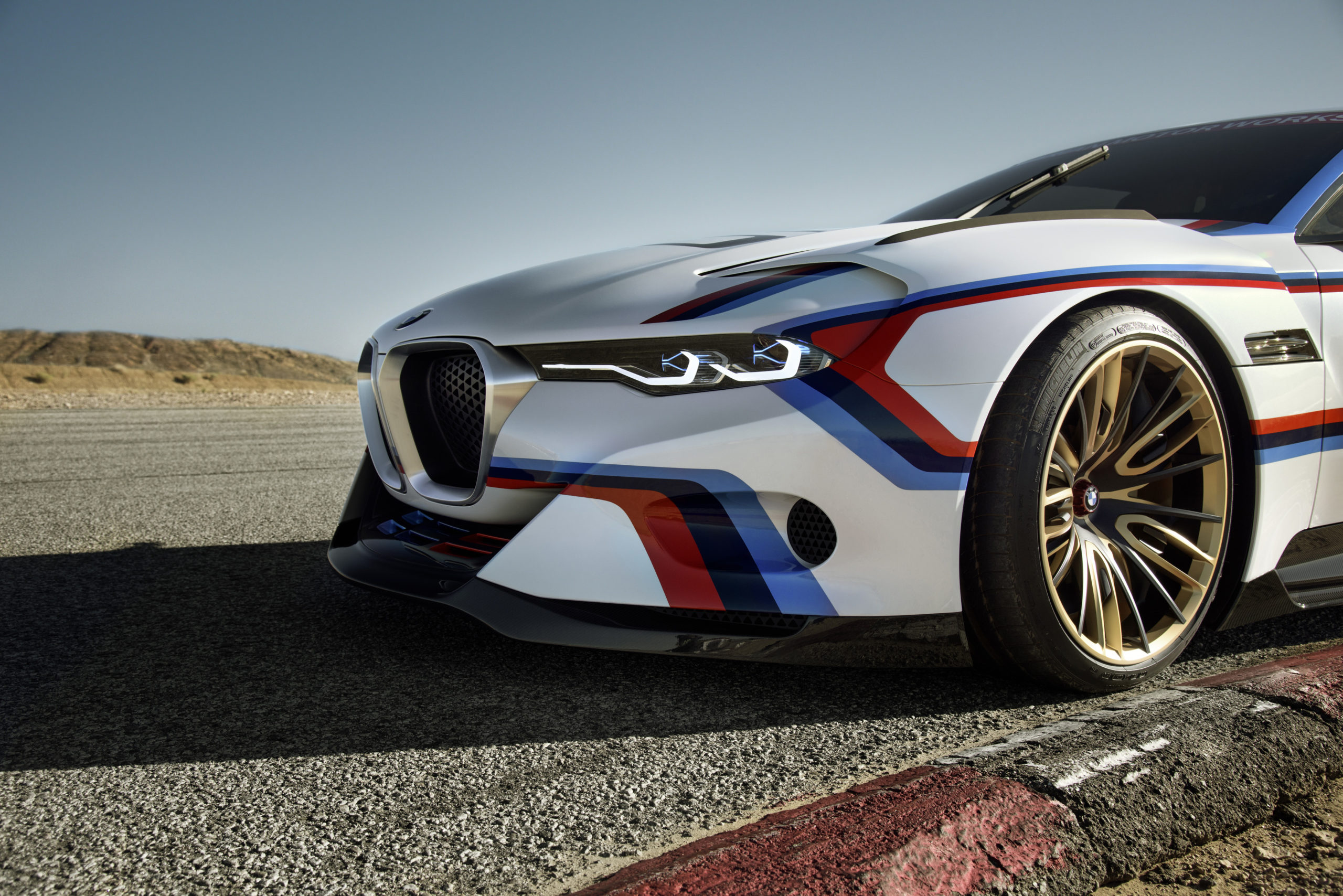
The colours and graphics used, not to mention the addition of a number 25 (the Imsa North American race car) show case the extraordinary record of success notched up by the works BMW 3.0 CSL in the 1970s. Swathes of exposed carbon fibre spotlight the 1970 model’s commitment to lightweight construction and, as a cutting-edge material, bring it into the modern era.
Power and athleticism – the front end
The front end of the CSL Homage R is one of the broadest and lowest of any model in the BMW family. The flow of the surfaces and graphic accents in the front apron showcase the car’s wheels and underline its wide, powerful stance.
In the centre of the front end is a large version of the signature BMW kidney grille, which references the upright form used at the time. The familiar four-eyed face with its laser lighting and LED technology enable a slim and modern light formation to bring it right up to date.
A stylised, blue-lit ‘X’ inside the lights separates the light functions from one another and, at the same time, recalls the X-shaped headlight taping used for endurance races.
The large, black front splitter made from carbon fibre sets the seal on the front end as it plunges down to the road. Together with the kidney grille, it creates a large stylistic aperture, providing a visual hint of the engine’s power and performance.
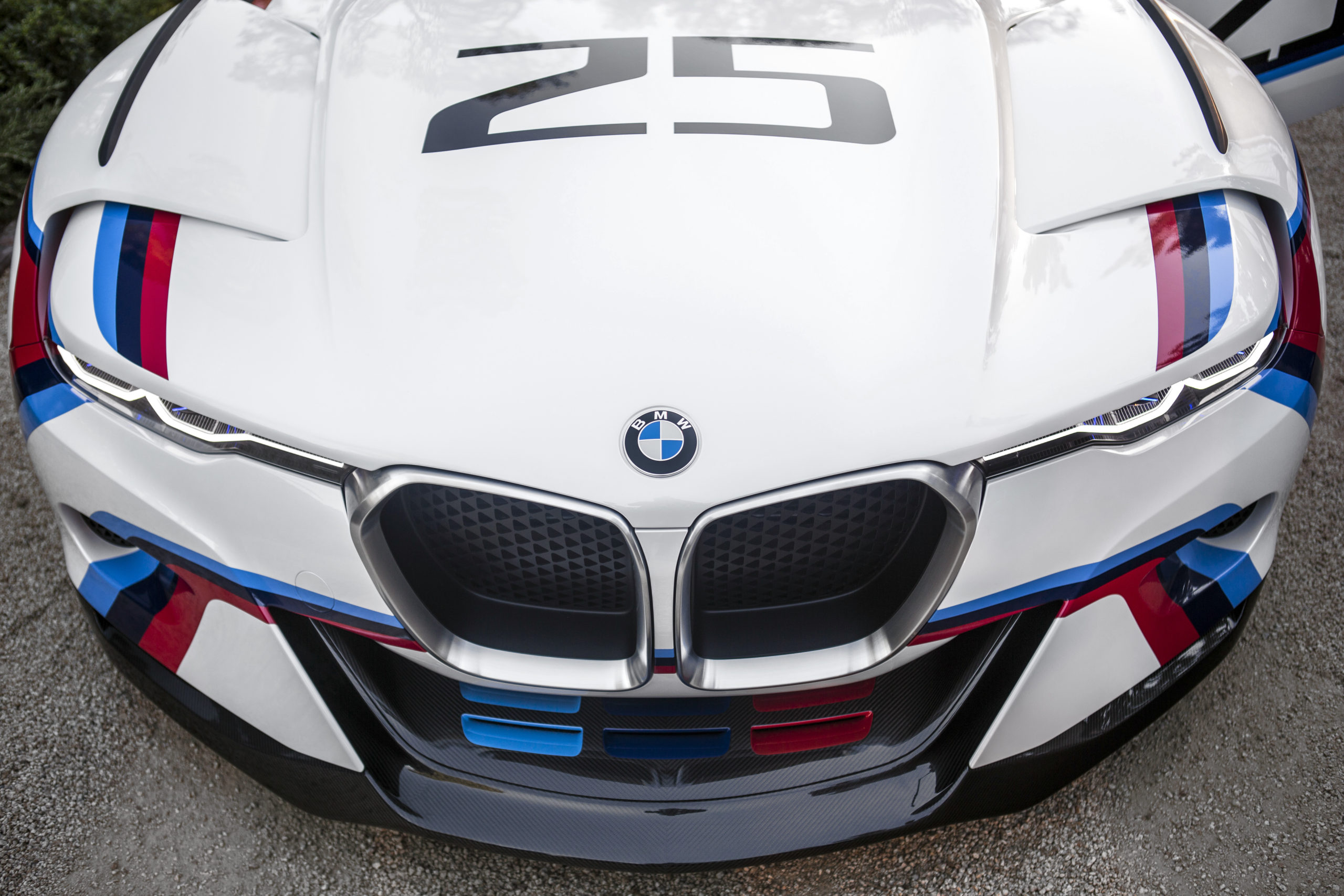
From the side, the front apron and kidney grille present a modern take on the classic trademark ‘shark nose’ design.
The rear end – muscular presence
The rear of the CSL Homage R makes a statement of maximum sporting intent. The large rear spoiler and carbon-fibre double diffuser are straight out of the racing car blueprint and brim with aerodynamic sophistication.
The contoured rear apron draws the eye to the car’s wheels and, in so doing, visually showcases its powerful haunch. The rear light design is particularly distinctive, a strip of LEDs extending along the spoiler to link the two lights.
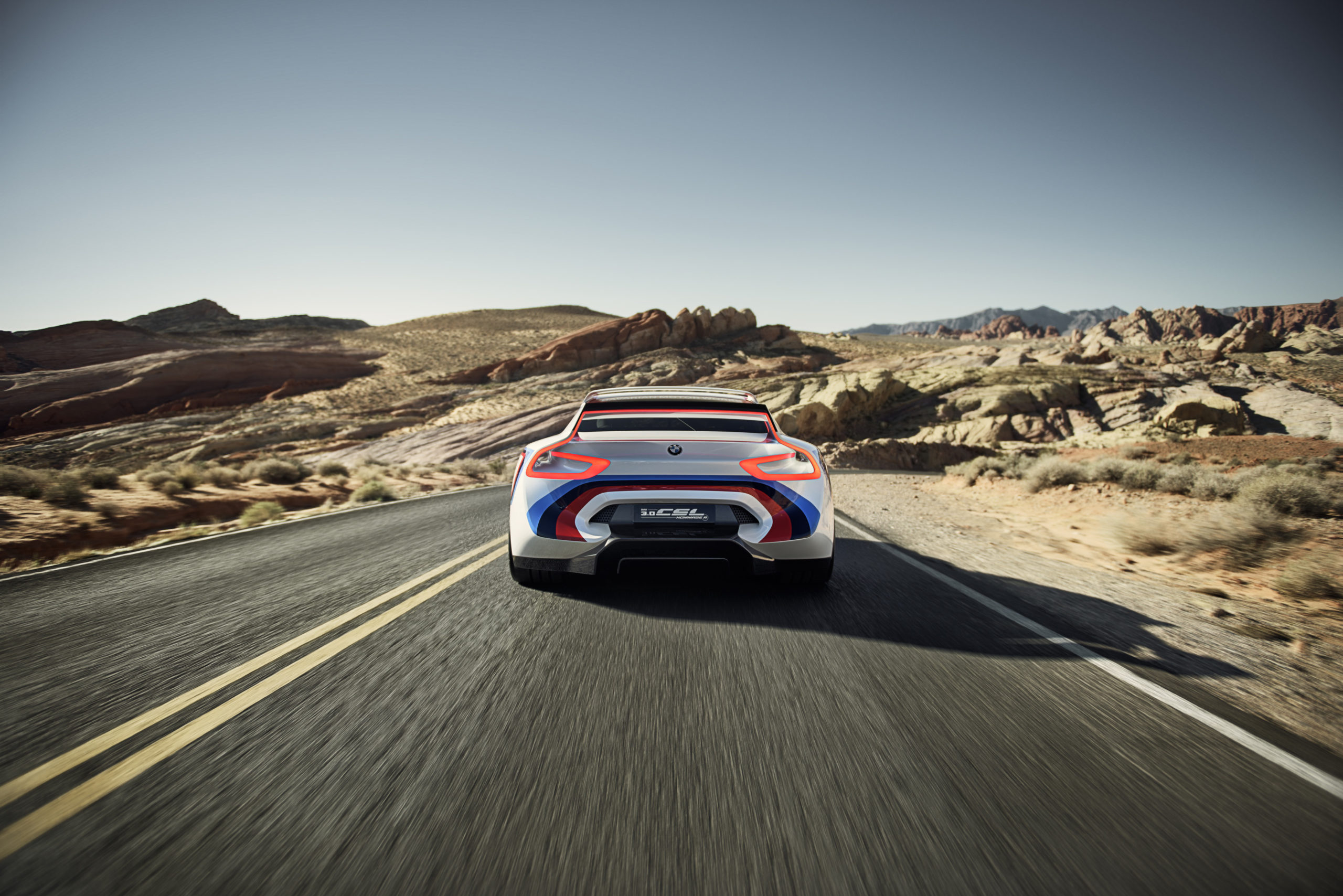
The CSL Homage R also cuts a dynamically imposing figure when viewed from above. The bonnet fans out in a wide ‘V’ from kidney grille to headlights, recalling a striking and dynamic element of earlier BMW coupes, and therefore combines all the classic BMW hallmarks within a modern and emotionally charged creation.
Words by John Castle & Richard Baxter
Images BMW Press, John & Richard
December 2015
